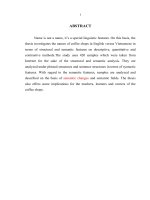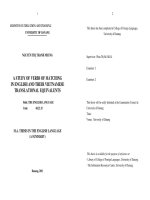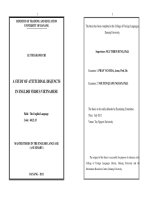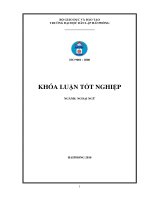Adsorption of ammonium (NH4+) ions onto various vietnamese biomas
Bạn đang xem bản rút gọn của tài liệu. Xem và tải ngay bản đầy đủ của tài liệu tại đây (1.75 MB, 22 trang )
Engineering Conferences International
ECI Digital Archives
Biochar: Production, Characterization and
Applications
Proceedings
8-20-2017
Adsorption of Ammonium (NH4+) Ions onto
various Vietnamese biomass residue-derived
biochars (wood, rice husk and bamboo)
Nguyen Van Hien
University of Birmingham, United Kingdom & Soils and Fertilizers Research Institute, Vietnam
Eugenia Valsami-Jones
University of Birmingham, United Kingdom
Nguyen Cong Vinh
Soils and Fertilizers Research Institute, Vietnam
Tong Thi Phu
Soils and Fertilizers Research Institute, Vietnam
Nguyen Thi Thanh Tam
Soils and Fertilizers Research Institute, Vietnam
See next page for additional authors
Follow this and additional works at: />Part of the Engineering Commons
Recommended Citation
Nguyen Van Hien, Eugenia Valsami-Jones, Nguyen Cong Vinh, Tong Thi Phu, Nguyen Thi Thanh Tam, and Iseult Lynch, "Adsorption
of Ammonium (NH4+) Ions onto various Vietnamese biomass residue-derived biochars (wood, rice husk and bamboo)" in "Biochar:
Production, Characterization and Applications", Franco Berruti, Western University, London, Ontario, Canada Raffaella Ocone,
Heriot-Watt University, Edinburgh, UK Ondrej Masek, University of Edinburgh, Edinburgh, UK Eds, ECI Symposium Series, (2017).
/>
This Abstract and Presentation is brought to you for free and open access by the Proceedings at ECI Digital Archives. It has been accepted for inclusion
in Biochar: Production, Characterization and Applications by an authorized administrator of ECI Digital Archives. For more information, please
contact
Authors
Nguyen Van Hien, Eugenia Valsami-Jones, Nguyen Cong Vinh, Tong Thi Phu, Nguyen Thi Thanh Tam, and
Iseult Lynch
This abstract and presentation is available at ECI Digital Archives: />
University of Birmingham
School of Geography, Earth, and Environmental Sciences
Adsorption of ammonium nitrogen (NH4+‐N) ions
onto various Vietnamese Biomass Residue–
derived Biochars (wood, rice husk and bamboo)
Presented by: Nguyen Van Hien –
Alba, Italy 2017
The context in Vietnam
‐ Low soil organic mater (OC<2%) due to fast decomposition under
tropical weather
‐ Low use effectiveness of N‐fertilizers: < 50%
‐ Several rivers and lakes polluted (ammonia, heavy metals)
‐ Several agricultural residues are burnt after harvesting
Rice straw after harvesting
Rice straw burnt on the field
Ash after burning
Research Goals
Soil Amendment:
C‐sequestration, nutrient
capture
Biomass
Soils
Biochar
Adsorbents:
Pollutant removal from
waste water
Methods
Biochar Production:
• Biomass residues: acacia wood chips, rice husk, and bamboo
• Production equipment: Top – Lid Updraft Drum (TLUD)
• Pyrolysis temperature : 450‐550 oC
Biomass
Pyrolysis
Biochar
Biochar production by TLUD Oven
Cut wood and bamboo
to fit across the drum.
Place rice husk then
bamboo/wood in layers
about 20cm high
Top layer is wood
Pyrolysis process
Then light fire
Methods (cont.)
Adsorption experiments:
• Biochar dosages: 0.25, 0.5, 1.0, 2.0g BC + 40 mL NH4+ (40mg/L,
pH=7), shaking 24h, To = 22±0.5 oC
• Adsorbate concentrations: 20, 40, 80, 160, 320 mg NH4+/L (40mL)
+ 0.5g BC, pH=7, shaking 24h, To = 22±0.5 oC
• Contact times: 30, 60, 90, 120, 240, 360 mins; 0.5g BC+ 40 mL
NH4+ (40mg/L, pH=7), To = 22±0.5 oC
Data analysis:
• Langmuir, Freundlich, and Temkin Isotherm models
• Pseudo‐First Order and Pseudo‐Second Order kinetic models,
Intraparticle Diffusion model
Results and Discussion
Chemical Properties of the Biochars
Parameters
pH
CEC, Cmol/kg
C,%
Volatile mater,%
Fixed carbon,%
Ash, %
Wood BC
Rice husk BC
Bamboo BC
10.11
13.53
82.11
46.56
46.06
1.93
9.51
26.70
47.82
45.61
7.82
41.24
9.94
20.77
80.27
48.72
37.09
8.08
• pH of the biochars: alkaline
• CEC and Ash: rice husk BC > bamboo BC > wood BC
• C and fixed carborn: rice husk BC < bamboo BC <
wood BC
SEM and BET Surface Area
600
500
479.34 ± 0.88
(m2/g)
434.53 ± 2.79
(m2/g)
400
300
200
3.29 ± 2.79
(m2/g)
100
0
Wood BC
Rice husk BC
Bamboo BC
Effect of Adsorbent Dosage on NH4+‐N Adsorption
3.00
80
70
2.50
2.00
Wood BC (mg/g)
Rice husk BC (mg/g)
Bamboo BC (mg/g)
Wood Bc (%)
Rice husk BC (%)
Bamboo BC (%)
1.50
1.00
50
40
30
% removal
qe (mg/g)
60
20
0.50
10
0
0.00
0
10
20
30
40
50
60
Concentration of BC (g/L)
• NH4+ adsorption decrease when increasing adsorbent dosages
• The adsorption: rice husk BC > bamboo BC > wood BC for 6.25 ‐
25g/L, but the same with BC dosages being higher 25g/L
• Increase in NH4+ removal with increasing adsorbent dosages
Effect of Adsorbate Concentrations on NH4+‐N Adsorption
60
12
55
10
50
qe (mg/g)
40
35
6
30
4
2
Wood Bc (mg/g)
Rice husk BC (mg/g)
Bamboo BC (mg/g)
Wood Bc (%)
Rice husk BC (%)
Bamboo BC (%)
% removal
45
8
25
20
15
0
10
0
50
100
150
200
250
300
350
Dose of adsorbate (mg/L)
• Strong adsorption increase when increasing adsorbate
concentrations.
• Decrease in the removals for wood and rice husk BCs with >40 mg
NH4+‐N/L and > 80mg/L for bamboo BC.
Effect of Contact Times on NH4+‐N Adsorption
1.90
60
1.80
55
1.70
50
1.50
45
1.40
1.30
% removal
qt (mg/g)
1.60
40
1.20
Wood BC (mg/g)
Bamboo BC (mg/g)
Rice husk BC (%)
1.10
Rice husk BC (mg/g)
Wood BC (%)
Bamboo BC (%)
35
1.00
30
0
100
200
300
400
500
600
Time (mins)
• Nearly equilibrium adsorption for wood BC after 30 mins.
• Strong NH4+ adsorption onto rice husk BC during 30‐60 mins.
• Dramatic decrease in adsorption for bamboo BC during 90‐120
mins before reaching equilibrium.
Isotherm Adsorption
Adsorbent
Langmuir model
qmax
KL
R2
Freundlich model
KF
1/n
R2
B
Temkin model
A
R2
Wood BC
‐8.097
‐0.28
0.9295
0.04
0.985
0.9658
2.645
‐2.662
0.9114
Rice husk BC
88.50
6.73
0.9111
0.14
0.801
0.9489
2.803
‐2.317
0.8994
Bamboo BC
‐12.55
‐0.64
0.9425
0.08
0.911
0.9460
3.063
‐2.516
0.9109
Surface diffusion
Pore diffusion
Surface diffusion
Pore diffusion
Surface diffusion
Surface diffusion
a) Monolayer adsorption
on homogenous surface
b) Multilayer adsorption on
heterogeneous surface
Kinetics of Adsorption
Adsorbents
Pseudo ‐ First Order Pseudo ‐ Second Order
qe‐exp, mg/g
qe‐cal1
K1
R2
qe‐cal2
K2
R2
Wood BC
1.36
0.09
0.002
0.9912
1.33
0.24
0.9999
Rice husk BC
1.85
0.02
0.002
0.3158
1.78
0.13
0.9998
Bamboo BC
1.53
‐
‐
‐
1.40
‐0.06
0.9982
400
350
t/qt
• Pseudo ‐ Second Order fits
well with the experimental
data
300
250
200
Wood BC
150
• The NH4+ adsorption governed 100
by chemical adsorption via CEC 50
0
and functional groups
0
y = 0.7497x + 2.351
R² = 0.9999
Rice husk BC y = 0.5624x + 2.5274
R² = 0.9998
Bamboo BC
100
200
300
Time (mins)
400
y = 0.7135x - 8.0815
R² = 0.9982
500
600
NH4+ adsorption by biochar
( Skurt A at al ,2011 )
Intraparticle diffusion
Step 1: NH4+‐N ions from
bulk solution transport to
external film around BC
2.0
qt (mg/g)
Step 2: Move to external
BC surface by film
diffusion
2.5
1.5
1.0
Wood BC
0.5
Rice husk BC
Bamboo BC
0.0
0
5
10
Time1/2
Step 3: Move into pores
and Intraparticle diffusion
occurs
Step 4: Adsorption
Adsorbent
Kid
15
1/2
(min )
20
Intraparticle diffusion
C
25
R2
Wood BC
0.013
1.574
0.9189
Rice husk BC
0.086
1.7148
0.7339
Bamboo BC
‐0.084
1.9907
0.6863
Intraparticle Diffusion Schemature
A B
C
Biochar particle Bulk solution External film NH4+‐N Internal pore diffusion and adsorption
Pore diffusion Adsorption
Desorption Surface diffusion
External suface Inaccessible fraction Inaccessible pore Accessible pore
Conclusion
• The three biochars are alkaline, high carbon content, with
significant differences in morphology (SEM).
• The results showed good adsorption for NH4+‐N in aqueous
solution, particularly rice husk BC.
• The adsorption was governed by chemical adsorption (CEC,
functional groups) on heterogeneous surface with multilayer
adsorption.
Acknowledgements
• Fundings by: Vietnam International Education Development (VIED) and EU FP7
EcofriendlyNano project (PCIG14‐GA‐2013‐631612)
• The excellent supports from Professors Iseult Lynch and Eugenia Valsami‐Jones,
Drs. Anastasios Papadiamantis, Maria Thompson, Lianne Hill, and Paul Stanley of
University of Birmingham (UK); Professor Stephen Joseph (University of New South
Wales, Australia); Do Duc Khoi (Population, Environment and Development Centre,
Vietnam); and Dr Nguyen Cong Vinh, Tong Thi Phu, Nguyen Thi Thanh Tam, and Le
Xuan Anh (Soils and Fertilizers Research Institute, Vietnam)
Thank You & Questions?









